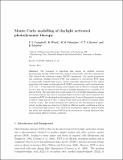Monte Carlo modelling of daylight activated photodynamic therapy
Abstract
The treatment of super cial skin lesions via daylight activated photodynamic therapy (PDT) has been explored theoretically with three dimensional (3D) Monte Carlo radiation transfer (MCRT) simulations. For similar parameters and conditions, daylight activated PDT was compared to conventional PDT using a commercially available light source. Under reasonable assumptions for the optical properties of the tissue, protoporphyrin IX (PpIX) concentration, and a treatment dose of 75 J cm-2, it was found that during a clear summer day an effective treatment depth of over 2 mm can be achieved after 30 min of daylight illumination at a latitude of 56 degrees North. The same light dose would require 2.5 h of daylight illumination during an overcast summer day where a treatment depth of about 2 mm can be achieved. For conventional PDT the developed model suggests that 15 min of illumination is required to deliver a light dose of 75 J cm-2, which would result in an e effective treatment depth of about 3 mm. The model developed here allows for the determination of phototoxicity in skin tissue as a function of depth for different weather conditions as well as for conventional light sources. Our theoretical investigation supports clinical studies and shows that daylight activated PDT has the potential for treating superficial skin lesions during different weather conditions.
Citation
Campbell , C L , Wood , K , Valentine , R M , Brown , C T A & Moseley , H 2015 , ' Monte Carlo modelling of daylight activated photodynamic therapy ' , Physics in Medicine and Biology , vol. 60 , no. 10 . https://doi.org/10.1088/0031-9155/60/10/4059
Publication
Physics in Medicine and Biology
Status
Peer reviewed
ISSN
0031-9155Type
Journal article
Collections
Items in the St Andrews Research Repository are protected by copyright, with all rights reserved, unless otherwise indicated.

